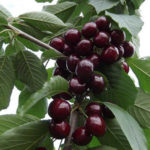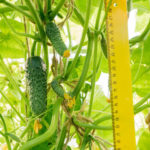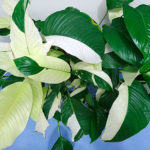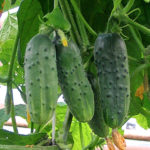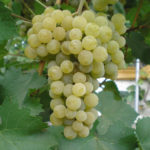Rose Folklore
The enduring popularity of hybrid tea roses is due to their ability to re-bloom. Choosing a worthy representative of this group in his collection, the rose grower also pays attention to the outer appearance of the bush, the color scheme and aroma. All these qualities are worthily combined in a variety called Folklore. It is not a novelty, it is a reliable and proven variety that many gardeners have been able to appreciate. But, unfortunately, as often happens, old varieties are slowly giving way to fashionable novelties. So it happened with our heroine, many novice rose growers may not even have heard of her. But true connoisseurs of beauty have remained faithful to this elegant flower, calling it the most reliable and hardy. According to experts, due to its frost resistance, the variety is perfect for growing in central Russia.
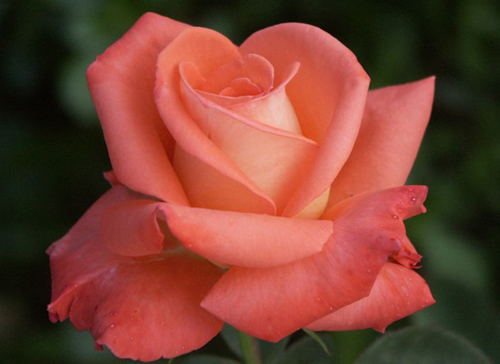
History of creation
The German rose-growing company Kordes does not need to be represented, the crops it creates are well known to the gardeners of the world and have received many awards. Our heroine also has German roots, she was created by Reimer Kordes. In 1977, the variety was introduced to the rose-growing world under the name Folklore, another name that was used for exhibitions is Selbar 1 105. The unique code name is KORlore. The German woman inherited her excellent qualities from her parents: a coral-red tea-hybrid variety from Tantau Fragrant Cloud (fragrant cloud) and an unnamed seedling.
Awards
Thanks to its characteristics and external data, Folklore was able to become a laureate of numerous competitions and win prestigious awards at world exhibitions. She, like no other rose, boasts a long list of prizes and titles:
- Best Greenhouse Rose and Best Palette Rosexpo Montreal, Canada 1999;
- Best Yellow Rose Golden Triangle Rose & Garden Society, USA 1999;
- Court of Snow / Honor obtained in the USA: Belleville Area Rose Society Summer Show 1999, Bowling Green Rose Society Summer Show 2000, Charleston Rose Society 1999, Columbus Rose Society 1999 and 2001, Cullman Rose Society 2001, Dallas Rose Society in 1999, Denver Rose Society in 2001, Des Moines Rose Society in 2001, Detroit Rose Society in 2000 and 2001, Forest City Rose Society in 2000, Fort Worth Rose Society in 2000 , Gateway Rose Society in 2000, Golden Isles Rose Society in 2001, Great Lakes District in 2001, Greater St. Louis Rose Society USA 2000, Houston Rose Society USA 1999, Iowa Rose Society 1999, Milwaukee Rose Society 2001, Minnesota Rose Society 2000, Nebraska State Rose Society 1999, Pittsburgh Rose Society 2000 and 2001, Topeka Rose Society in 2001, Warren Rose Society in 1999 and 2001, Western Reserve Rose Society in 2000;
- King of shows received in the USA: Clay Rose Society 2001, Cleveland Rose Society 1999, Fort Vancouver Rose Society 2000, Grand Valley Rose Society (Colorado) 1999, Iowa Rose Society 2001, Las Cruces Rose Society in 2000, Minnesota Rose Society in 1999, Nashville Rose Society in 2001, Olympia Rose Society in 1999, Syracuse Rose Society in 2001, Thumb in 2001;
- Princess Shaw: Des Moines Rose Society USA 1999 and 2000, Huron Valley Rose Society USA 1999, Kalamazoo Rose Society USA 1999, Kansas City Rose Society USA 2000, Maryland Rose Society USA 1999, Moundbuilder's Rose Society USA 1999, Northeastern Illinois Rose Society USA 1999, Spokane Rose Society USA 2001, Syracuse Rose Society USA 2001, Western Reserve Rose Society USA 1999, Yankee District USA 2000, Golden Triangle Rose & Garden Society Canada 1999;
- Queen of Shaw, all nominations received in the USA: Clay Country Rose Society in 2000, Del-Chester Rose Society in 2000, Duneland Rose Society in 1999, Fox River Valley Rose Society in 2001, Garden Clab of Marion in 1999 and 2001, Huntington Rose Society 1999, Indianapolis Rose Society 1999, Millstream Rose Society 2001, Philadelphia Rose Society 2000, Richmond Rose Society 1999 and 2001, Sauk Trial Rose Society 1999, Savannah Rose Society in 2001, Warren Rose Society in 2000;
- W.J. Keenan Bowl (CRS), Canadian Rose Society National Rose Show, Canada 1999
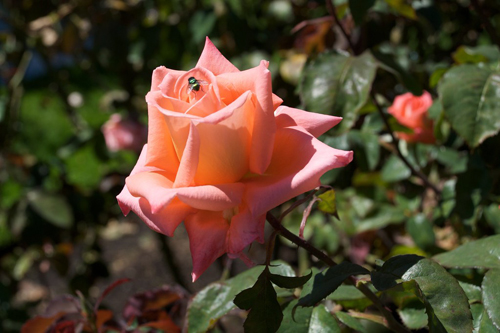
Description
Folklore has good growth vigor. The rose bush is erect, branched, rather lush and has a vase-like shape. According to various sources, its height in temperate climates reaches from 100 to 150 cm.But in favorable climatic conditions, Folklore easily grows up to 2.5 meters, so many gardeners, given this ability and the strong branching of the variety, grow it as a climbing crop. In width, the perennial grows up to 1.0 meters, sometimes a little more - up to 1.5 meters. Shoots are strong, straight, moderately covered with thorns, sometimes strongly. The foliage is good. Leaves are large, dark green, pinnate, with a shiny surface. The young growth has a bright crimson color. Shoots that grow in the first wave of flowering, as a rule, end in a single flower, on the subsequent ones, large flower brushes are often formed, consisting of 7 - 8 or more buds.
The rosebud is very tall, pointed, incredibly elegant. As it unfolds, the flower of the Folklore variety takes on a classic shape, with long, folded petals forming a raised center.The petals are dense to the touch, their apex is strongly bent back, often forming sharp corners. When fully expanded, a yellow center is visible. The flower rosette looks quite magnificent, due to the fact that it consists of 44 - 50 petals, the diameter of the flower is 10 - 13 cm. The plant fascinates at first glance with the overflow of shades of a double flower rosette. The petals are bicolor. In the beginning, they are dark orange-pink. In the opening phase, the inner side of the petals is salmon pink, the outer side is creamy yellow. Folklore's coloration is influenced by the season and weather conditions, depending on which the color can be rich orange or bright coral, or slightly paler - soft salmon.
Flowering period
Folklore refers to the re-blooming roses. Blooms in tides during the season. The first wave, beginning in late May or early June, is abundant, bright and long-lasting. In summer, it declines, during this period the plant often forms only single buds. Then, closer to autumn, it gives out a second, no less abundant wave. Flower rosettes last quite a long time, buds in inflorescences open one by one. The aroma is very strong, intense, sweetish. Although some rose growers call him weak. The color can fade in direct sunlight to light, almost creamy shades.
Characteristics
- Folklore is a fairly winter-hardy culture. Without shelter, she is able to winter in zones 7 and 6 of the USDA (according to the USDA) at temperatures down to -23.3 ° C. According to some reports, it is suitable for growing 5 in the USDA zone, where the temperature drops to -28.9 ° C, but needs to be insulated for the winter;
- the awakening buds of a charming rose are sensitive to recurrent frost. Therefore, in cool regions, there is no need to rush to remove the shelter, do it gradually;
- the immunity is declared quite good. The plant shows good resistance to black spot, but less resistance to powdery mildew. True, some rose growers argue that resistance to black spot is often not high enough. Of the pests, aphids are the most harmful. But bronzes, despite the strong aroma of the flower, do not often bother Folklore;
- according to gardeners, the plant is quite resistant to rain. In a period of high humidity, petals with a dense structure do not deteriorate. But tightly twisted buds may never open;
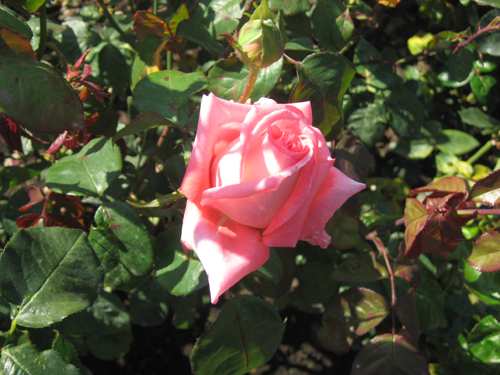
- drought resistance of the rose is not bad. But still, you should not test the queen of flowers for strength, with a lack of moisture, the growth of shoots and the formation of buds slows down, the foliage can wither. But for watering done on time, Folklore will thank you with even more decorativeness;
- the ability to withstand high air temperatures is excellent - even in the heat, the petals do not melt;
- the variety is also good as a cut variety. A strong, slender leg and a tall bud look quite exquisite in a vase. In addition, the outlet does not lose its freshness for a long time.
Agrotechnics
You can plant a rose in central Russia in spring - from mid-April to early May, when the soil warms up to + 10 ° C, and even better to + 12 ° C. In the southern regions, planting is best done in the fall, in October. The site should be well lit, but in the south it is desirable that at midday the plant is covered with diffused partial shade. Slightly airing the area will help keep the spread of fungal infections under control. But in order to finally protect the culture from diseases, it is necessary to carry out preventive spraying. Watering should be sufficient, especially in hot weather. But the soil in the root zone should not be waterlogged, this can lead to a root infection. Folklore is very responsive to feeding, which is applied at least once a month.Usually, in central Russia, our heroine in winter just needs to insulate the root zone with a layer of mulch of at least 15 cm.But if the winter is unfavorable, or the perennial is grown in a cooler region, it is worth taking care of covering the entire bush. Rose pruning is carried out according to the standard for hybrid tea varieties.
Beauty Folklore is a very unpretentious culture, even a novice gardener can grow it. The perennial has frost resistance sufficient for central Russia; during preventive spraying, health will not fail and the decorativeness of the perennial will not suffer from diseases. And the rains do not pose a threat to the blossoming flowers at all.
The spectacular beauty of the rose will transform any corner of the garden or park area. In warm regions, tall shrubs can serve as an excellent backdrop for smaller crops, and can also be used as a climbing plant to decorate a gazebo, pergola or decorative column. Medium-sized bushes look harmoniously in a rose garden, in a flower bed, in mixborders. Despite the bright color, our heroine goes well with varieties of red, orange, yellow and white. As a cut-off plant, the Folklore variety, which retains the freshness of the flower rosette for a long time, can form the basis for a chic bouquet.
